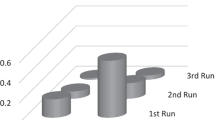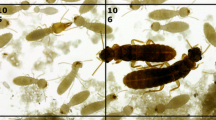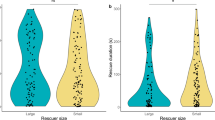Summary
The colony-moving ofMyrmica rubra L. was induced in he laboratory by worsening the microclimate of the nest.
A detailed analysis of the whole process is given; it is based both on observation and on traffic measurements between the old and the new nests. Three periods can be recognized: exploration, emigration, and final exploration. Two recruitment methods occur, initiated by distinct motor displays: group recruitment takes place first, whilst carrying behaviour becomes the main technique later.
The organization of the group is described. The recruiter extrudes its sting while returning to the old nest and while leading the group. Tracks left on soot-coated glasses are analyzed. Sticks crushed with either the poison gland or the Dufour's gland are effective in leading the ants.
Most adult carrying postures are typical for myrmicines: the occurrence of atypical postures is discussed. All the carrying acts (of brood and adults) are effected by 25% of the workers (on average); carrying activity is age-dependent. The stability of the group of carriers is tested during successive emigrations.
Social regulation potentiality is strong: even queens or callows can move with their larvae when isolated from the rest of the colony.
Resume
Le déménagement de sociétés deMyrmica rubra L. a été induit en laboratoire en dégradant le microclimat des nids.
L'analyse détaillée du processus de déménagement s'appuie sur l'observation et sur la mesure du trafic entre l'ancien et le nouveau nid. On distingue trois phases: l'exploration, l'émigration, et l'exploration finale.Myrmica rubra utilise deux modes de recrutements initiés par des comportements d'invitation distincts: les recrutements de groupe dominent au début, les transports par la suite. L'organisation du groupe est étudiée. Le «leader» émet une phéromone issue de l'appareil à venin. Nous avons tenté d'en préciser l'origine glandulaire (glande de Dufour ou glande à poison) par des expériences de leurre et l'analyse de traces sur du noir de fumée.
La plupart des transports se font selon la position typique des myrmicines; la signification des transports atypiques est discutée. Le transport de compagnes ou de couvain est effectué par 25% des ouvrières (en moyenne), dont la majorité montre une forte pigmentation cuticulaire. La stabilité de ce groupe d'ouvrières transporteuses est testée au cours de déménagements successifs.
Le pouvoir de régulation sociale est élevé: des reines ou des jeunes ouvrières isolées du reste de la colonie peuvent mener un déménagement à bien.
Similar content being viewed by others
References
Brian M.V., 1974. — Brood-rearing behaviour in small cultures of the antMyrmica rubra L.Animal Behav., 22, 879–889.
Cammaerts M.C., 1977. — Recrutement d'ouvrières vers une source d'eau pure ou sucrée chez la fourmiMyrmica rubra L. (Formicidae).Biol. Behav., 2, 287–308.
Cammaerts M.C., Morgan E.D., Tyler R., 1977. — Territorial marking in the antMyrmica rubra L. (Formicidae).Biol. Behav., 2, 263–272.
Cammaerts-Tricot M.C., 1974 a. — Production and perception of attractive pheromones by differently aged workers ofMyrmica rubra L. Ins. Soc., 21, 235–248.
Cammaerts-Tricot M.C., 1974 b. — Recrutement d'ouvrières chezMyrmica rubra L. par les phéromones de l'appareil à venin.Behaviour, 50, 111–122.
Cammaerts-Tricot M.C., 1975. — Ontogenesis of the defense reactions in the worker ofMyrmica rubra L. (Hymenoptera, Formicidae).Anim. Behav. 23, 124–130.
Cammaerts-Tricot M.C., Verhaeghe J.C., 1974. — Ontogenesis of the trail pheromone production and trail following behaviour in the workers ofMyrmica rubra L. (Formicidae).Ins. Soc., 21, 275–282.
Crewe R.M., Blum M.S., 1970. — Alarm pheromones in the genusMyrmica (Hymenoptera, Formicidae).Z. Vergl. Physiol., 70, 363–373.
De Vroey C. — Mesure de l'agressivité chezMyrmica rubra (= Myrmica laevinodis, Formicidae).Biol. Behav. (In press.)
De Vroey C., Pasteels J.M., 1978. — Agonistic behaviour of the antMyrmica rubra L.Ins. Soc., 25, 247–265.
Dlussky G.M., Voltzit O.V., Sulkhano A.V., 1978. — Organization of group foraging in ants of the genusMyrmica.Zool. Z.H., 57, 65–77.
Dobrzanska J., Dobrzanski J., 1976. — The foraging behavior of the antMyrmica laevinodis Nyl.Acta Neurobiol. Exp., 36, 545–559.
Dobrzanski J., 1966. — Contribution to the ethology ofLeptothorax acervorum (Hymenoptera, Formicidae).Acta Biol. Exp., 26, 71–78.
Eidmann H., 1927. — Ameisen und Blattlaüse.biol. Zentralblat. 47, 537–555.
Hangartner W., 1969. — Structure and variability of the individual odor trail inSolenopsis geminata Fabr. (Hymenoptera, Formicidae).Z. vergl. Physiol., 62, 11–120.
Hölldobler G., 1971. — Recruitment behavior inCamponotus socius (Hymenoptera, Formicidae).Z. Vergl. Physiol., 75, 123–142.
Lane A., 1977. — Recrutement et orientation chez la fourmiLeptothorax unifasciatus. Rôle de la piste et des tandems.Thèse de doctorat, Dijon.
Le Masne G., 1953. — Observations sur les relations entre le couvain et les adultes chez les fourmis.Ann. Sci. Nat. Zool., 15, 1–56.
Meudec M., 1976. — Rôle des stimulations provenant du couvain sur le comportement de transport des nymphes par les ouvrières deTapinoma erraticum (Formicidae-Dolichoderinae).C. R. Acad. Sci. Paris, 282, 1041–1043.
Meudec M., 1977. — Le comportement de transport de couvain lors d'une perturbation du nid chezTapinoma erraticum (Dolichoderinae). Rôle de l'individu.Ins. soc., Paris, 24, 345–352.
Möglich M., 1973. — Communication during nest-moving in ants.VIIth IUSSI Congr., London, pp. 274–278.
Möglich M., 1973. — Social organisation of nest emigration inLeptothorax (Hym., Form.)Ins. Soc., 25, 205–225.
Möglich M., Hölldobler B., 1974. — Social carrying behaviour and division of labour during nest-moving in ants.Psyche, 81, 219–236.
Möglich M., Hölldobler B., 1975. — Communication and orientation during foraging and emigration in the antFormica fusca.J. Comp. Physiol., 101, 275–288.
Pasteels J.M., Verhaeghe J.C., 1974. — Dosage biologique de la phéromone de piste chezMyrmica rubra L.Ins. Soc. 21, 167–180.
Rosengren R., 1971. — Route fidelity, visual memory and recruitment behaviour in foraging wood ants of the genusFormica.Acta Zool. Fennica, 133, 1–106.
Weir J.S., 1958. — Polyethism in workers of the antMyrmica.Ins. Soc., 4, 97–125.
Author information
Authors and Affiliations
Rights and permissions
About this article
Cite this article
Abraham, M., Pasteels, J.M. Social Behaviour during nest-moving in the antMyrmica rubra L. (Hym. Form.). Ins. Soc 27, 127–147 (1980). https://doi.org/10.1007/BF02229249
Received:
Accepted:
Issue Date:
DOI: https://doi.org/10.1007/BF02229249




